Karnak Temple at Luxor and the Temple of Hathor at Dendera
Dec 22, 2003
![]()
Karnak Temple
Karnak, constantly in a state of enlargement for over 13 centuries, is the largest temple in Egypt. It is located in on the east bank of the ancient city of Thebes (now Luxor). Karnak is dedicated to the supreme sun-god Amun. Karnak designates the "center of the world" where Amun first created himself and then the universe. He was the guarantor of the survival of the universe that he had created and the kingdom was ruled by his "beloved son" the Pharaoh (whoever that might be at the time).
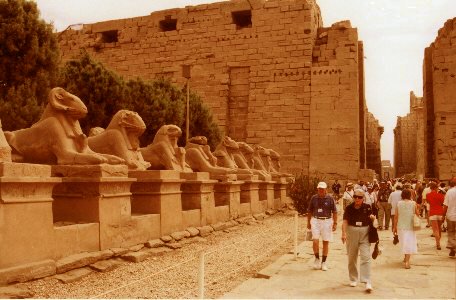 |
The ram-headed sphinxes, the symbol of the god Amun, on the "Avenue of Sphinxes", shows the Pharaoh, standing between the paws, being protected by Amun. This avenue used to run two miles to the temple of Luxor but most of it has been destroyed. |
| Unfortunately the day we were at Karnak the sun was hidden behind an overcast sky and my pictures did not turn out well. But, here you see the Sacred Lake for ritual navigation and washings. The lake was surrounded by living quarters for the priests and an aviary for aquatic birds. ver 2,000 years. | 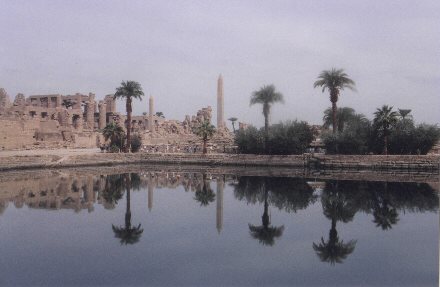 |
![]()
Dec 31, 2003
Palace Intrigues
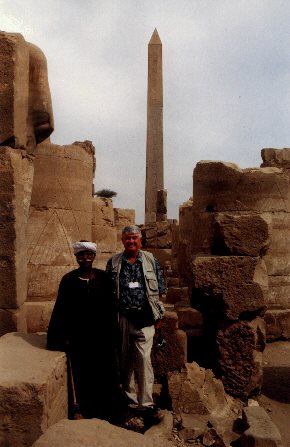 |
Since Karnak was the center of the universe its only natural that each
Pharaoh would add something to commemorate his rule. Of course back during
the new kingdom (1550-1350 B.C.) a woman could never be Pharaoh - or couldn't
she? During the 18th Dynasty Thutmose III enlarged the Temple of Amun and built two tall granite obelisks celebrating his rule. Thutmose had an older daughter and a very young son when he died. His daughter, Hatshepsut, being the nice lady she was took care of her brother, the Thutmose's young son and became the Queen Regent. As a dutiful daughter Hatshepsut built the largest obelisk ever - even to this day - in the Temple complex. Her name is all over the obelisk celebrating the things she did - but to make sure everything was on the up and up she has a little comment that this obelisk was dedicated to her great father King Thutmose III. |
Eventually Queen Hatshepsut started wearing men's clothing and even tied on a false beard to designate that she was the Pharaoh. Everyone forgot about her little brother and he was lost to history. Hatshepsut had a problem however; Since she was a Pharaoh she certainly didn't want to be buried in the Valley of Queens in west Thebes and yet since she was a woman she couldn't be buried in the Valley of the Kings.
| So, she solved the problem by building her own funeral temple between the two valleys and it is exactly in line with the Avenue of the Sphinxes as you leave Karnak Temple. | 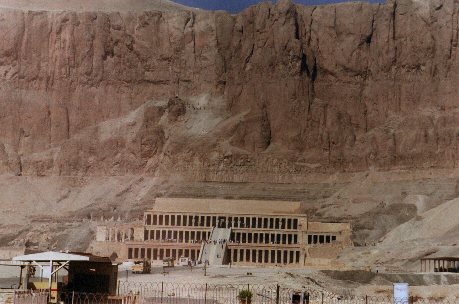 The Temple is so large you can see it 3-4 miles west of the Nile when you are on the east side of the Nile in Luxor. P.S. King Thutmosis is not the famous King Tut. |
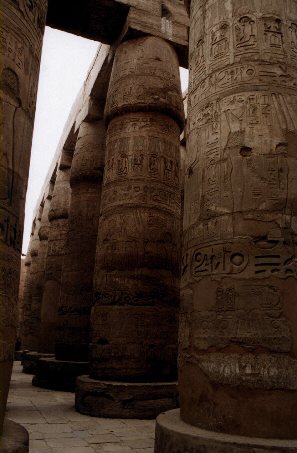 |
Jean-Fancois Champollion, a French linguist, was the first person to decipher the hieroglyphs in 1822 from the Rosetta Stone. After having developed the alphabet he traveled to Egypt and traveling up the Nile he visited Dendera (our next stop) and Karnak. Of Karnak he observed, "The temple was built for people 60 feet tall". |
| Now I, like Jean-Fancois, am able to read all the inscriptions on the pillars and pylons and obelisks and temples and tombs. Oh, how exciting it must have been to find large columns capped with the rough papyrus reed capitals and other columns from a later epoch capped with fine delicate lotus flowers. | 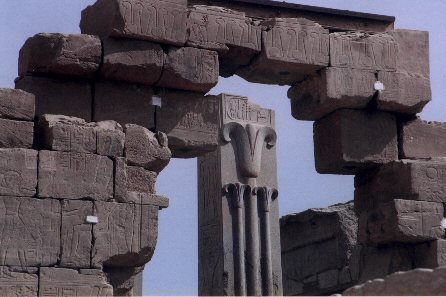 |
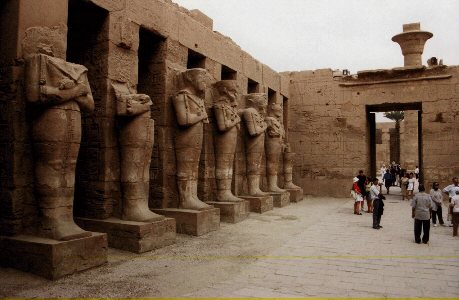 I have been advised that this is in the Court of Ramses III with Osiris pillers. |
As you walk through the Karnak Temple you find alcoves everywhere dedicated
to some god or goddess on behalf of some Pharaoh. Can you guess which god
this one is dedicated to? I don't have the foggiest recollection. So much to remember. So much to see and so little time. |
| By the time we were dragged kicking and screaming away from the temple we had our choice of transportation. Walk, steal a bike, or catch a ride in one of the many beautiful horse drawn carriages. Which one did we choose? The air conditioned bus, of course. | 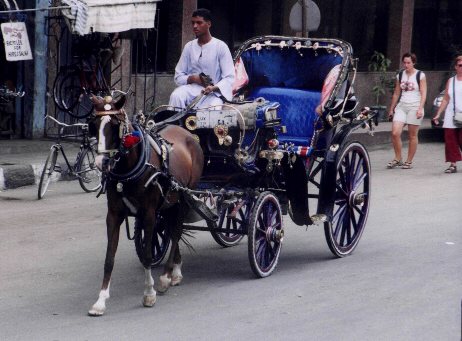 |
Jan 2, 2004
Jan , 2004
The Temple of Hathor at Dendera
| "Re (Ra) opened his eyes inside the lotus as it emerged from primordial chaos and his eyes began to weep and droplets fell to the ground; they were transformed into a beautiful woman who was named Gold of the Gods, Hathor the Great, Mistress of Dendera" And so Hathor, wife of Horus, was born. | 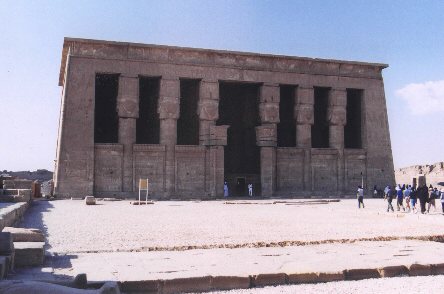 |
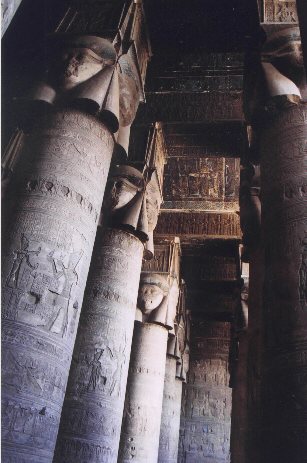 |
There were many temples to Hathor but this one is the best preserved and once you stepped inside you knew immediately why it
is such a treasure. This is the only temple left in Egypt which still has its roof - in fact we climbed the winding staircase to the top for a magnificent view of the surrounding countryside. Once inside the temple you find 18 columns with the head of the goddess, with its cows ears, reproduced on the capitals. Because of the roof the room is dark and photographs are difficult. Flash photography is forbidden so this is the best I could do. |
When viewing the Egyptian temples the viewer notices the intricate carvings on the walls and columns are devoid of color. Mark Millmore, who has a wonderful web page on Egypt, tells us this does not give us an accurate impression of these works of art.
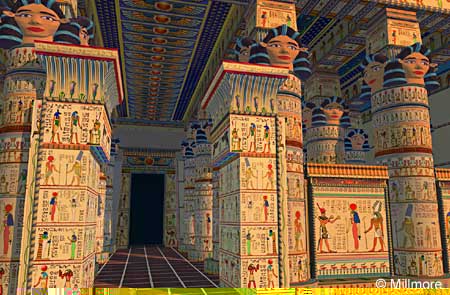
"All Ancient peoples liked to decorate their buildings and temples with bright colours. Take the Parthenon, in Athens, for example; nowadays we have this vision of those beautiful columns and fabulously carved marbles showing the bare stone, which appeals to our modern ascetic. However, in ancient times the bare stone was hidden from view because it was all painted in the most brilliant colours. [This reconstruction] give[s] some idea of how these buildings might have appeared to ancient eyes."
The color in these temples has been washed out by the sun over the past thousands of years and it is only is the sheltered areas where they can be seen. At Dendera there are a lot of these areas because the roof has remained intact. Use of flash photography is prohibited, except in limited areas. When walking around Dendera temple I was approached by an Egyptian who motioned me to follow him into the back of the building not visited by many people. He showed me several artificially lit rooms where the color was still present.
By properly setting my camera on a small tripod to a delayed time exposure I was able to get a picture.
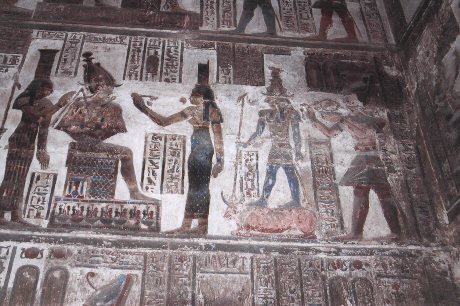
The Egyptian held out his hand clearly wanting a tip for having shown me this area of the temple. I was more than happy to give him 5 Pounds ($1.00)
Such invitations were offered to me time and again in the temples - someone would walk up to me and ask if I was an American. When I responded in the affirmative they would say, "America is good." or something to that effect and then offer to take me to a special point where a good photograph could be taken. I always took them up on the offer. Fran, being more cautious than I am, was always afraid that the guy would take me off to some dark corner and beat me to a pulp and steal my camera. As a precaution she always walked off and we agreed to meet somewhere. That way she could always call the police if I disappeared for a long time. Or at least she felt she could. There were always a lot of people around and I felt safe. Sometimes I got good pictures and sometimes I got nothing but most importantly I always had a memory of a great adventure.
![]()
Jan 9, 2004
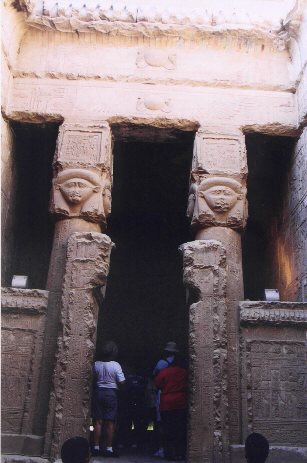 |
In the Chapel of Sanctity the mysteries of the birth of the cosmic order out of the primordial chaos were celebrated. Imagine, if you can, what this might have looked like in living color. As usual the ceilings were 50 feet tall and taking a flash photograph was difficult but I tried. |
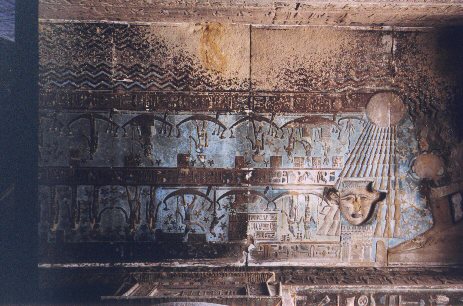
The Egyptians thought of the earth as the center of the universe and the
sun, rotating around the earth would set every night when it was eaten by
Nut, a female goddess whose body spanned across the heavens. In the morning
the sun was born again. You can't see it clearly in this photo but you can
see the sun being born by Nut. Believe it or not the ancient Egyptians had
figured out a calendar of 365 days a year divided into three periods of four
months each based upon the flow of the Nile. In the photo above you can see
some of the color in the carvings - these were protected because they are
painting on the ceiling.
![]()
Jan 11, 2004
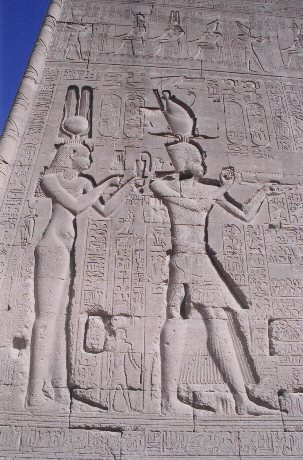 |
I may have mentioned it before but it is interesting enough to repeat it again. At the temple of Hathor at Dendera we find the only remaining mention of Cleopatra and her son Caesarion - the son of Julius Caesar. As you know Cleo and Julius had a thing going and although Julius had a couple wives back in Rome it never hurt to have another one in some far flung kingdom which helps to cement the relationship between it and Rome. |
| I imagine, Bes, the god of court jesters and the strangely mutilated dwarf who is the patron saint of childbirth, would be laughing at the whole thing. | 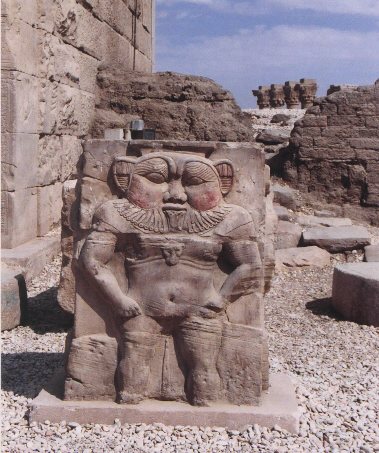 |
Once again we boarded our bus and headed back to our boat. This time we sailed south, up the Nile, toward Luxor.
![]()
Jump Station
Go to The Egyption Museum of Cairo - Under Construcion
Go to The Religious Faiths - Under Construction Go to Street Scenes of Cairo - Under Construction Go to Who are the Gods? - Under Construction. Go to Chapter 9: The Khan el-Khali Bazaar - Under Construction Go to Chapter 8: The Pyramids - Under Construction Go to Chapter 7: East Thebes and the Temple of Luxor - Under Construction Return to Chapter 6: The Pyramids.Return to Chapter 5: Karnak Temple at Luxor and the Temple of Hathor at Dendera.
>Return to Chapter 4: Kom Ombo, Edfu, Karnak and Dendera.
Return to Chapter 3: Cruising Down the Nile.
Return to Chapter 2: Abu Simbel and Aswan.
Return to Chapter 1: Introduction to Egypt.
Read about my version of The Gods of Egypt and Diagram of Temples.
Return to Belli's Home Page
![]()
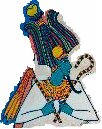
For more information about our travels write to![]() Belli.
Belli.
